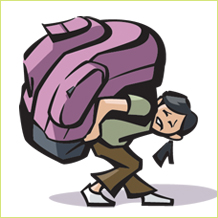Which of the following does not increase your risk for back pain?
a. Smoking
b. Being overweight
c. Doing moderate exercise
d. Being stressed
b. Being overweight
c. Doing moderate exercise
d. Being stressed
Answer
c. Moderate exercise actually helps prevent back pain because it stretches and strengthens your back muscles (and muscles supporting your back), reducing your chance of injury. Exercise is often part of recovery from chronic back pain. However, people with back pain from a sudden injury or fall should check with their doctors before doing any type of exercise.
What is the best way to sleep to protect your back?
a. On your side
b. On your back
c. On your stomach
b. On your back
c. On your stomach
Answer
a. The American Academy of Family Physicians (AAFP) recommends sleeping on your side with your knees bent. Can't fall asleep on your side? The AAFP recommends back sleepers put a pillow under their knees and a small pillow under their lower back, and stomach sleepers put a pillow under their hips.
How much do Americans spend annually on healthcare related to back problems?
a. $175 million
b. $558 million
c. $17 billion
d. $32 billion
b. $558 million
c. $17 billion
d. $32 billion
Answer
d. Back problems cost Americans $32 billion in healthcare alone, according to figures released by the Agency for Healthcare Research and Quality in 2008. That makes it the ninth most expensive health condition in the country.
Answer
b. False. Surgery is a last resort for people with chronic back pain. Most chronic back pain is treated with one or more of the following: hot and cold packs, exercise, medications, behavior changes, and steroid or numbing shots.
Research has shown as many as 60 percent of healthy adults without back pain have:
a. Degenerative changes in the spine
b. Excellent posture
c. Desk jobs
d. Low blood pressure
b. Excellent posture
c. Desk jobs
d. Low blood pressure
Answer
a. Sixty percent of healthy adults who underwent back scans had degenerative changes in their spine. Because of these findings, doctors often don't send patients with back pain for MRIs, X-rays, or other imaging right away. Identifying abnormalities on a scan doesn't necessarily identify the cause of a person's back pain, since so many people have abnormalities that don't cause pain.
Children's backpacks should weigh no more than ___ percent of their body weight?
a. 10
b. 15
c. 20
d. 25
b. 15
c. 20
d. 25
Answer
b. Children's backpacks should weigh no more than 15 percent of their body weight. The American Academy of Pediatrics recommends that parents look for lightweight backpacks with padded shoulder straps and a padded back, as well as a waist belt and multiple compartments, which help even out the weight in the backpack. Backpacks should be worn with both straps and shouldn't hang below the lower back.





